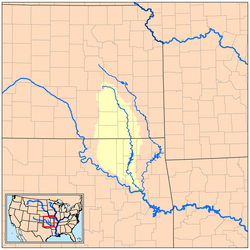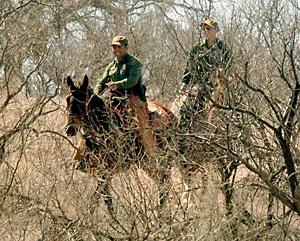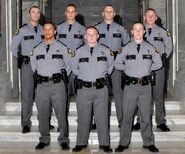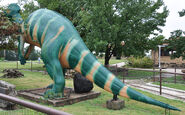| The following 1983: Doomsday page is under construction.
Please do not edit or alter this article in any way while this template is active. All unauthorized edits may be reverted on the admin's discretion. Propose any changes to the talk page. |
|
| |||||
| Anthem | "Land of the Hills and Prairie" | ||||
| Capital (and largest city) |
Independence | ||||
| Other cities | Caney, Sedan, Longton, Neodensha, Fredonia, Dewey, Nowata, Bartlesville | ||||
| Language | English | ||||
| Religion main |
Secular State | ||||
| others | Methodist, Roman Catholic, Southern Baptist, other Christian denominations. | ||||
| Ethnic Groups main |
White | ||||
| others | Native American, Black | ||||
| Demonym | Verdigrisian | ||||
| President of the Council | |||||
| Population | approximately 60,000 | ||||
| Currency | Barter, NAU Dollar | ||||
Etymology
The Verdigris (pronounce the s) is a river in southeast Kansas and northeast Oklahoma. Its name comes from the Spanish Verde-Gris, "Green-Gray". It is almost certainly a reference to the river's coloration. The same colors can be seen in the flag.
The regime that developed into Verdigris was originally called Montgomery, and it was in effect an extension of the pre-1983 government of Montgomery County. As its influence extended over other settlements to the north and south, it adopted the name Verdigris after the nearby river. The major towns in the nation - Independence, Coffeyville, Fredonia, Neodesha, and Bartlesville - all lie within the Verdigris River's watershed.
History
Geography

Map of the Verdigris River Watershed.
Verdigris is composed of nine city-states, plus some smaller affiliated villages and a few allied nomadic groups, located along a north-south axis that roughly follows the Verdigris River in southeast Kansas and northeast Oklahoma.
Government
Verdigris is a loosely knit confederation of city-states dominated by the capital, Independence. Each of the various towns governs itself according to its own distinct traditions. Some are democratic republics, others are absolute dictatorships, and most fall in between.
The Council of Verdigris is the governing body. It meets three times a year. It is made up of several leaders from each of the nine member towns, with the number of votes of each town in rough proportion to its population. A few smaller villages not affiliated to any town, along with one or two nomadic groups, also send delegations, each with just one vote. The Marshal of Independence is ex officio President of the Council.
Each town also has its own judiciary, for the most part very underdeveloped. The District Court of Montgomery County, which consists of the judges in the town of Independence, functions as an appellate court.
Economy
Agriculture
Wheat is the most grown food. Other foods that are grown are corn, soybeans, beans, peanuts, sunflowers, oats, pecans, rye, grain, and hay.
Industry
Military
The military is the base of power for Verdigris and indeed its reason for existing. Its main branches are the Army, the Air Force, and the Reserves.
The Army of the Verdigris has 1000 soldiers and is made up of the fighting forces of each member town. When combined, they are divided into a dragoon battalion (semi-mounted) and a cavalry battalion (fully mounted), each with 500 men, and again divided into ten companies of 100 personnel, with small units armed with machine guns, and some other light weapons unit. A majority of the arms used have been scavenged from abandoned military bases or purchased from the reformed United States. They operate no armored forces due to the cost, though horses have taken the place of armor for the most part. Indeed, one could mistake a Verdigrisian soldier for an 1800s era cowboy, except for the modern weapons that the soldier carries. Naval operations on one of the nation's various rivers are handled by the Army, which operates ten boats.

Two Verdigrisian dragoons on patrol.
In their separate towns, members of the Army serve as police and security officers. Most serve part time, working as farmers or in other jobs when not actively training or patrolling. The bulk of their weapons were scavenged from police stations and SWAT units throughout the region. Typically, officers on patrol are armed with either the Browning Hi-Power handgun, or the S&W Model 15, a nightstick, and equipped with handcuffs. They have an assortment of weapons to use in situations of unrest, including M16 assault rifles, Remington Model 870 shotguns, and H&K MP5 submachine guns.
The Air Force has around 30 pilots. Cessna had a manufacturing facility in Independence for producing single-engine aircraft, including the 172 Skyhawk, the 182 Skylane, the 206 Stationair and the all-composite TTx. This factory was brought back to working order in the mid-2000s under the Cessna name. Aircraft are exported to Texas, the United States, the Lincoln Republic, and Utah. The facility had produced approximately one aircraft a day at its height; today it's only about 18 each year.
In addition, 14 aircraft are grounded in Coffeyville Municipal Airport and Independence Municipal Airport. Though most of them have been grounded since Doomsday, two aircraft, a scout and cargo plane, both operated by the military have been flown infrequently since the mid-2000s.
The Reserves consist of all males between the age of 18 and 35. They are required to perform service for two separate weeks per year. Services are staggered to prevent mass depopulation of jobs on certain days. To date, the Reserves have never been mobilized. Their main purpose is as a source of recruitment to the regular forces, as the best-performing Reservists are often brought into the Army.
Equipment
A majority of military equipment used by the armed forces has been scavenged from abandoned military bases and converted civilian equipment. To keep common ammunition, the government has attempted to keep units armed with weapons using the same caliber or gauge, simplifying supply chains.
There are some light, medium and heavy machineguns in use, scavenged over the decades or discovered by scouts. These weapons are mainly used in support roles, but are attached to towing equipment, and a wheeled sled for cavalry to utilize in support.
Sabers and other bladed weapons are commonly used by cavalry and most foot soldiers are issued bayonets. Some are issued hatchets as tools as well as weapons.
Small quantities of explosives, mainly Molotov cocktails and gas bombs are used. There are some grenades manufactured using gunpowder and steel casings.







